An Introduction to Perimeter Control in Construction
Have you ever wondered how construction sites maintain safety while ensuring environmental protection and promoting productivity?
The secret lies in efficient perimeter control.
But, what is perimeter control? And why is it so essential in the construction industry?
In this comprehensive guide, we examine the concept of perimeter control, its various types, importance, and common materials used. We’ll also look at some regulatory guidelines linked to perimeter control. Through this article, we aim to enhance your understanding of effective site management in construction.
Did you know that effective perimeter control can prevent unauthorized access, protect local water bodies from sediment runoff, and significantly improve a site’s safety profile?
Let’s learn more!
Table of Contents
Understanding Perimeter Control in Construction

Definition of Perimeter Control
Perimeter control in construction refers to the measures and techniques used to manage and protect the boundaries of a construction site. This can include physical barriers, erosion controls, and other protective actions to ensure safety, prevent unauthorized access, and manage environmental impact.
Types of Perimeter Control
There are several types of perimeter control strategies commonly used in construction:
- Fencing: Physical barriers such as chain-link, wooden, or temporary fencing to restrict site access.
- Silt Fencing: Fabric barriers designed to intercept and filter sediment-laden runoff.
- Jersey Barriers: Concrete or plastic barriers often used to prevent vehicular access.
- Temporary Berms: Raised areas of soil used to divert runoff and control erosion.
- Signage: Warning and informational signs to guide workers and visitors.
Importance of Perimeter Control
Understanding why perimeter control is essential can help in better site management:
- Safety: Protects workers and the public from potential hazards.
- Security: Prevents theft and unauthorized access to the site.
- Environmental Protection: Manages erosion and sediment control to protect local water bodies.
- Compliance: Meets regulatory requirements and standards for construction sites.
Common Perimeter Control Materials
A few frequently used materials in perimeter control include:
| Material | Usage |
|---|---|
| Chain-Link Fence | Site security and access control |
| Geotextiles | Erosion and sediment control |
| Concrete Barriers | Vehicle management and boundary definition |
Regulatory Guidelines
Regulations surrounding perimeter control are vital for compliance. For example, the EPA (Environmental Protection Agency) often provides guidelines for sediment and erosion control, particularly for larger construction sites. You can read more about these guidelines on the EPA’s official website.
In summary, perimeter control in construction is a comprehensive approach that involves multiple strategies to manage site boundaries effectively. It plays an essential role in ensuring safety, security, and environmental compliance.
Putting Perimeter Control into Practice

Effective Planning for Perimeter Control
Planning for perimeter control is a critical step in any construction project. Contractors must conduct a site-specific risk assessment to identify potential challenges and hazards. Identifying factors such as the nature of the work, environmental conditions, topography, and the surrounding area help formulate an effective perimeter control strategy.
Customize Perimeter Control to Suit Site Conditions
Every construction site has unique characteristics. Therefore, the controls used should be tailored to its specific needs. For example, construction sites in urban areas may need sound barriers in addition to the usual safety and security barriers, while those adjacent to water bodies may require extra erosion control measures.
Ways to Enhance Perimeter Control
In addition to the standard techniques, there are additional ways to reinforce perimeter control:
- Access Control: Incorporating advanced systems such as biometric scanner gates or security check booths to provide an additional layer of security.
- Technology: Employing advanced technology such as surveillance cameras or drones for 24/7 monitoring of the site.
- Lighting: Ensuring adequate lighting for night-time to deter unauthorised access and enable secure construction work after dark.
Training and Capacity Building
Perimeter control is not just about barriers and physical measures. The human component is equally important. Training programs for construction staff can increase awareness of perimeter control importance and help identify potential risks or breaches. Regular tool talks about perimeter control and reinforcement strategies can help ensure the success of the implemented control measures.
Checking The Effectiveness of Perimeter Control
Once the measures are in place, it’s important to inspect them regularly to ensure their effectiveness. Regular inspections can spot weaknesses or potential breaches in the control measures and guide required adjustments.
The Future of Perimeter Control
With advancements in technology, the face of perimeter control is changing rapidly. We can expect to see advanced forms of physical barriers, greater use of geospatial technologies for site analysis, and innovative materials that offer better erosion control. Construction Dive is a great resource for staying updated about these changes in the industry.
Remember – When it comes to perimeter control, the aim is to secure the construction site while minimizing its impact on the environment and ensuring safety for everyone involved in or interacting with the site.
What are Physical Perimeter Controls?

Different Types of Physical Perimeter Controls
Physical perimeter controls are tangible barriers and measures that are employed to ensure that unauthorized individuals are kept out of construction sites. These controls serve to protect both the construction site and the public. Here are additional types that weren’t covered:
- Barbed Wire: Typically used on top of fences to deter climbing intruders.
- Turnstiles: Controlled access points to ensure that only authorized personnel can enter.
- Bollards: Short, sturdy vertical posts typically used to prevent vehicular access.
- Anti-Climbing Devices: Spikes or other materials mounted to fences to discourage climbing.
Benefits of Physical Perimeter Controls
Using physical controls has several benefits:
- Visible Deterrence: A physical barrier can serve as a strong visible cue that the area is restricted.
- Increased Security: Physical barriers make it more difficult for unauthorized personnel to gain access, thereby enhancing security.
- Environmental Benefits: Some barriers like silt fences and geotextiles also help in controlling erosion and managing sediment, contributing to environmental protection.
Challenges in Implementing Physical Perimeter Controls
While physical controls are essential, they come with challenges:
- Cost: Physical barriers can be expensive to install and maintain.
- Installation Time: Setting up comprehensive physical controls can be time-consuming.
- Maintenance: Physical barriers require regular maintenance to remain effective, which adds to the overall project cost and time.
Advanced Technologies in Physical Perimeter Controls
Modern construction sites are increasingly leveraging technology to enhance traditional physical perimeter controls. Here are some high-tech solutions:
- RFID Gates: Radio Frequency Identification gates can track and monitor all movements in and out of the construction site, ensuring that only authorized personnel are present.
- Smart Fencing: Integrated systems that combine fencing with sensors and alarms to alert site managers of any breach in real-time.
- Geofencing: Uses GPS technology to create virtual boundaries around a construction site; if a person or vehicle exits the designated area, the system sends notifications to the site manager.
Legal and Compliance Aspects
Physical perimeter controls must comply with various legal and regulatory standards:
- OSHA Standards: The Occupational Safety and Health Administration (OSHA) provides regulations that construction sites must comply with, including safe fencing practices and site access control.
- Local Building Codes: Many municipalities have their own building codes that stipulate the types of barriers and controls that can be used.
- Environmental Regulations: In addition to federal bodies like the EPA, states have their own environmental regulations that may dictate specific types of sediment and erosion control.
For more detailed government guidelines on construction perimeter safety, you can refer to the OSHA’s official website.
Physical perimeter controls remain a foundational element in construction site safety and security. With evolving technologies and stringent regulations, the methods continue to advance, ensuring safer and more secure construction environments.
Final Thoughts on Perimeter Control
The scope of perimeter control extends well beyond the literal boundaries of a construction site. It requires thoughtful planning, customization to specific site conditions, and frequent monitoring.
By utilizing a variety of physical barriers and technology, the construction sector steadily improves site safety, reduces environmental impact, and mitigates against unauthorized access.
While implementing perimeter control measures can initially seem costly and time-consuming, the potential consequences of lax site boundaries underline the necessity of these precautions. Future advancements promise more diverse and sophisticated strategies.
As in any industry, staying informed is crucial, thus resources like the official OSHA and EPA websites are invaluable.
Frequently Asked Questions – FAQs
What is perimeter control in construction?
Perimeter control in construction refers to managing and protecting the boundaries of a construction site. This includes measures such as physical barriers, erosion controls, and other actions that ensure safety and prevent unauthorized access.
Why is perimeter control important in construction?
Perimeter control is important for numerous reasons. It ensures the safety of workers and the public, prevents theft and unauthorized access, helps manage erosion and sediment, and it helps the construction project comply with regulatory requirements and standards.
What are some types of perimeter control in construction?
Common types include fencing, signage, and temporary berms, among others. Advanced technologies such as surveillance cameras and lighting may also be used to enhance perimeter control.
What are some common challenges in implementing physical perimeter controls?
Some challenges include the cost and time of installation and maintenance. Regular checks and repairs are necessary to ensure their effectiveness, which can add to the overall project cost and time.
What is the future of perimeter control?
The future of perimeter control is expected to see advancements in technology, creating more advanced forms of physical barriers, greater use of geospatial technologies, and innovative materials that provide better erosion control.






